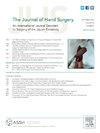Biomechanical Analysis of Transosseous Repair Versus Combined Transosseous With Capsular Repair for Triangular Fibrocartilage Complex Tears With Instability
IF 2.1
2区 医学
Q2 ORTHOPEDICS
引用次数: 0
Abstract
Purpose
This study compared the biomechanical stability of transosseous repair and transosseous combined with capsular repair techniques to reattach the triangular fibrocartilage complex (TFCC) for distal radioulnar joint instability.
Methods
Eight adult cadaveric upper-extremity specimens were studied. Each underwent peripheral ulnar-sided detachment of the deep and superficial TFCC fibers and repair. Four groups were prepared sequentially: intact TFCC, disrupted TFCC, transosseous repair, and combined transosseous with capsular repair. Forearm rotational torque was measured in three wrist positions: 60° flexion, neutral position, and 60° extension. Maximum dorsal and palmar ulnar translations in response to a 20-N traction load were measured at nine wrist positions after stabilizing the humerus and radius. Measurements were taken before and after TFCC disruption and following repair.
Results
Clear instability of the radius relative to the ulna was observed after sectioning the deep and superficial fibers of the TFCC, and stability was markedly improved after reconstruction in all positions. Compared with the normal group, rotational torque was similar between the two repair methods. In the pronation palmar flexion and supination dorsal extension positions, dorsal-palmar translation was smaller in the combined transosseous with capsular repair group than in the transosseous repair-alone group.
Conclusions
Triangular fibrocartilage complex deep fibers are the primary stabilizing structure of the distal radioulnar joint. In this cadaveric study, the combined transosseous with capsular repair technique demonstrated less dorsal-palmar translation compared with the transosseous-alone repair technique.
Clinical relevance
Combined transosseous with capsular repair is expected to provide improved postoperative stability for patients with peripheral TFCC tears and distal radioulnar joint instability.
对三角纤维软骨复合体撕裂伴不稳定性进行经骨修复与经骨联合韧带修复的生物力学分析。
目的:本研究比较了经骨修复和经骨结合囊修复技术的生物力学稳定性,以重新连接三角纤维软骨复合体(TFCC)治疗远端桡肘关节不稳定:方法:研究了八具成人上肢尸体标本。方法:研究了八具成人上肢尸体标本,每具标本都接受了尺侧外周TFCC深层和浅层纤维离断和修复手术。依次制备了四组标本:完整的 TFCC、断裂的 TFCC、经骨膜修复以及经骨膜与关节囊联合修复。在三种手腕位置测量前臂旋转扭矩:屈曲 60°、中立位和伸展 60°。在稳定肱骨和桡骨后,在九个手腕位置测量了20 N牵引负荷下的最大尺骨背侧和掌侧平移。测量在 TFCC 破坏前后和修复后进行:结果:在切断TFCC的深层和浅层纤维后,观察到桡骨相对于尺骨明显不稳定,而在重建后,所有位置的稳定性都明显改善。与正常组相比,两种修复方法的旋转扭矩相似。在代偿掌屈位和上翻背伸位,经骨关节囊联合修复组的背掌平移小于经骨关节囊单独修复组:结论:三角纤维软骨复合体深层纤维是桡侧远端关节的主要稳定结构。在这项尸体研究中,与单独经骨修复技术相比,联合经骨与关节囊修复技术显示出较少的背掌平移:临床意义:经骨与关节囊联合修复有望改善外周TFCC撕裂和远端桡侧关节不稳定患者的术后稳定性。
本文章由计算机程序翻译,如有差异,请以英文原文为准。
求助全文
约1分钟内获得全文
求助全文
来源期刊
CiteScore
3.20
自引率
10.50%
发文量
402
审稿时长
12 weeks
期刊介绍:
The Journal of Hand Surgery publishes original, peer-reviewed articles related to the pathophysiology, diagnosis, and treatment of diseases and conditions of the upper extremity; these include both clinical and basic science studies, along with case reports. Special features include Review Articles (including Current Concepts and The Hand Surgery Landscape), Reviews of Books and Media, and Letters to the Editor.

 求助内容:
求助内容: 应助结果提醒方式:
应助结果提醒方式:


